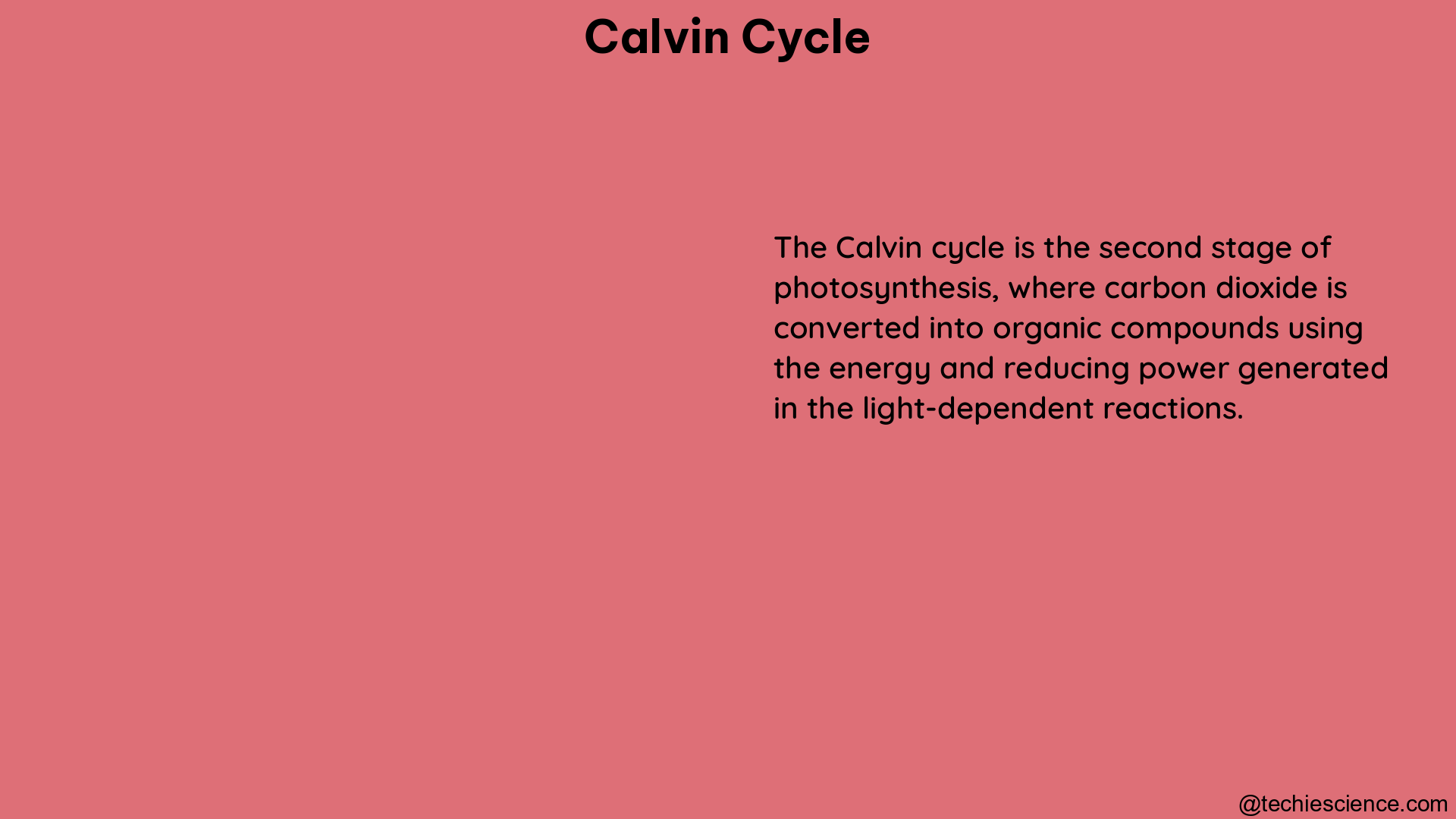The Calvin cycle, also known as the Calvin-Benson-Bassham cycle, is a crucial phase of photosynthesis that occurs in the stroma of chloroplasts in plants, algae, and cyanobacteria. This cyclic series of biochemical reactions converts carbon dioxide (CO2) into organic compounds, primarily glucose, which serve as the building blocks for various carbohydrates essential for plant growth and development.
Understanding the Calvin Cycle: Key Phases and Reactions
The Calvin cycle can be divided into three main phases:
-
Carbon Fixation: This phase is initiated by the enzyme ribulose-1,5-bisphosphate carboxylase/oxygenase (RuBisCO), which catalyzes the carboxylation of the 5-carbon sugar, ribulose-1,5-bisphosphate (RuBP), to form two molecules of 3-phosphoglycerate (3-PGA).
-
Reduction: The 3-PGA molecules are then reduced to glyceraldehyde-3-phosphate (G3P) using the energy and reducing power (ATP and NADPH) generated during the light-dependent reactions of photosynthesis.
-
Regeneration: The majority of the G3P molecules are used to regenerate the CO2 acceptor molecule, RuBP, through a series of enzymatic reactions. This ensures the continuation of the Calvin cycle.
Measuring Calvin Cycle Inputs: Profiling Sugar Phosphates

Measuring the inputs and intermediates of the Calvin cycle is crucial for understanding its function and regulation. One approach to this is by profiling the sugar phosphates using high-performance liquid chromatography-mass spectrometry (HPLC-MS) with mixed-mode stationary phases. This method allows for the qualitative and quantitative analysis of various sugar phosphates, such as:
- Ribulose-1,5-bisphosphate (RuBP)
- 3-Phosphoglycerate (3-PGA)
- Glyceraldehyde-3-phosphate (G3P)
- Dihydroxyacetone phosphate (DHAP)
The data obtained from this analysis can provide valuable insights into the levels and dynamics of these key Calvin cycle intermediates, which can be used to optimize the cycle’s efficiency and productivity.
Measuring Enzyme Elasticities: Insights into Calvin Cycle Regulation
Another approach to understanding the Calvin cycle is by measuring the elasticities of the enzymes involved in the cycle. Elasticity is a measure of how the rate of an enzyme-catalyzed reaction responds to changes in the concentration of its substrates or products. By determining the elasticities of Calvin cycle enzymes, researchers can gain insights into the regulation of the cycle and the control of carbon fixation.
Some of the key Calvin cycle enzymes and their elasticities include:
| Enzyme | Elasticity |
|---|---|
| RuBisCO | Measures the sensitivity of RuBisCO activity to changes in substrate (CO2) and product (3-PGA) concentrations |
| Phosphoglycerate kinase | Measures the sensitivity of the enzyme to changes in ATP, ADP, and 3-PGA concentrations |
| Glyceraldehyde-3-phosphate dehydrogenase | Measures the sensitivity of the enzyme to changes in NADPH, NADP+, and G3P concentrations |
| Fructose-1,6-bisphosphatase | Measures the sensitivity of the enzyme to changes in fructose-1,6-bisphosphate and inorganic phosphate concentrations |
Understanding the elasticities of these enzymes can provide insights into the regulation of carbon fixation and the control points within the Calvin cycle.
Kinetic Modeling of the Calvin Cycle
Kinetic modeling of the Calvin cycle can also offer valuable insights into the cycle’s function and regulation. Researchers have developed improved kinetic models of the cyanobacterial Calvin cycle using random sampling techniques. These models have identified probabilistic conditions for metabolome stability and metabolic flux control, which align with experimental data and can aid in engineering efforts to enhance the cycle’s efficiency and productivity.
Key features of these kinetic models include:
- Identification of the key enzymes and metabolic steps that control the cycle’s flux and stability
- Determination of the optimal conditions for metabolome stability and metabolic flux control
- Insights into the regulation of the Calvin cycle and the control of carbon fixation
By integrating these kinetic modeling approaches with experimental data, researchers can gain a deeper understanding of the Calvin cycle and develop strategies to optimize its performance for various applications, such as biofuel production, carbon sequestration, and sustainable agriculture.
Conclusion
The Calvin cycle is a fundamental process in photosynthesis, playing a crucial role in global carbon cycling and offering potential for industrial applications. By measuring Calvin cycle inputs, determining enzyme elasticities, and developing kinetic models, researchers can gain valuable insights into the cycle’s function and regulation. These approaches provide quantifiable data on the cycle’s intermediates, enzymes, and metabolic fluxes, which can be used to enhance the efficiency and productivity of the Calvin cycle for a wide range of applications.
References:
- Measure Calvin cycle inputs by profiling sugar phosphates using HPLC-MS with mixed-mode stationary phases, validated for qualitative and quantitative analysis. Link
- Measuring in vivo elasticities of Calvin cycle enzymes. Link
- The Calvin cycle revisited. Link
- Kinetic modeling of the Calvin cycle identifies flux control and stable metabolomes in Synechocystis carbon fixation. Link
- Lab Bio 3 Flashcards – Quizlet. Link

The lambdageeks.com Core SME Team is a group of experienced subject matter experts from diverse scientific and technical fields including Physics, Chemistry, Technology,Electronics & Electrical Engineering, Automotive, Mechanical Engineering. Our team collaborates to create high-quality, well-researched articles on a wide range of science and technology topics for the lambdageeks.com website.
All Our Senior SME are having more than 7 Years of experience in the respective fields . They are either Working Industry Professionals or assocaited With different Universities. Refer Our Authors Page to get to know About our Core SMEs.